
by Larry Williams | Jan 6, 2022
Q. When is citrus fruit ready to harvest?
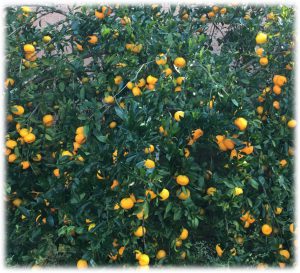
Satsuma fruit ready to harvest. Photo credit: Larry Williams
A. Florida uses five indexes to determine maturity of citrus, including soluble solids, juice content, acid level, soluble solids/acid ratio and skin color. But, the home gardener can easily decide when most citrus types are ready to be harvested. As the fruit reaches full size and the skin color changes from green to greenish yellow to orange, simply pick some fruit and taste it to see if it is sweet. If not, wait a little longer (a week or two) and taste test another fruit. Meyer lemons are ready when the skin color changes from green to greenish yellow. Satsuma fruit may be ready to eat before the skin becomes completely orange, especially if the early fall is warm. Kumquats are usually at their peak in taste when they become fully orange.
Citrus fruit does not ripen additionally after it is harvested. So, let it mature sufficiently on the tree.
Harvest season for satsuma is October to December. Harvest season for Meyer lemon is November to March. Harvest season for kumquat is November to April. Most grapefruit have a harvest season from November to May. Harvest season for sweet oranges varies. Early season oranges are harvested October to January, mid-season oranges are harvested December to February and late-season cultivars are harvested March to June. Citrus fruit may mature a little earlier in the harvest season on mature trees and more toward the end of the harvest season on young, vigorous trees.
Q. What cold-hardy citrus is best for North Florida?
A. Citrus species are tropical and subtropical in origin. As a result, citrus is not well suited for extreme North Florida. Commercial citrus production has progressively moved further south in Florida due to historic freezes. So, you’d be wise to choose the more cold-hardy citrus types for our area. But, even cold-hardy citrus can be severely injured or killed by a hard freeze in North Florida.
Some of the better choices for cold-hardy citrus in North Florida include kumquat, satsuma, calamondin and Meyer lemon. There has been some success with grapefruit and sweet oranges in our area. Lemon and lime are much less likely to survive in North Florida. There has been some discussion concerning future success with growing citrus a little more north in its current range related to climate change. There already has been some success with growing the more cold-hardy citrus types such as satsuma and kumquat in middle Georgia. We’ll see how this works out.
More information on cold-hardy citrus is available from the UF/IFAS Extension Office in your County and through this link. https://crec.ifas.ufl.edu/extension/trade_journals/2018/2018_june_coldhardy.pdf
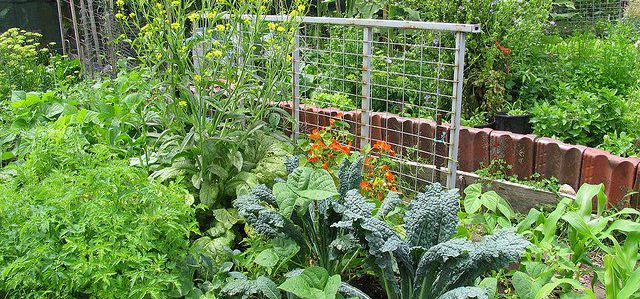
by Matt Lollar | Jan 6, 2022
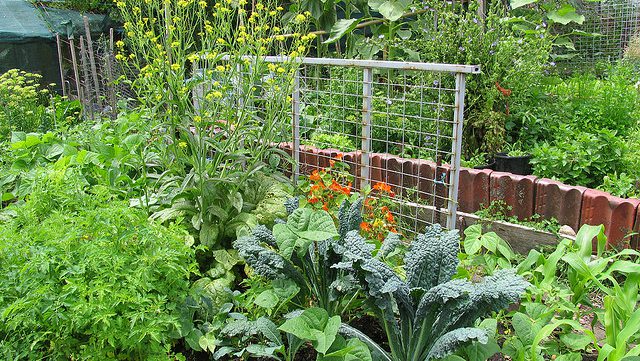
A mixed vegetable garden. Photo Credit: eXtension.org.
It’s never too early to start thinking about your spring vegetable garden. Have you ever wondered how much it costs to grow your own vegetables? Does it cost less to grow your own vegetables or buy them from the grocery store or farmers market? A number of factors are involved with answering these questions and budgeting for your home garden.
Materials
The materials used are specific to your own vegetable garden. If you do everything by hand you may need a hoe, rake, and spade along with a number of other tools you can use from year to year. When budgeting for you garden you would need to think about the life expectancy of these tools. Let’s say a $20 rake lasts for 10 years. In that case, you would budget $2/year ($20 ÷ 10 years = $2/year) for the rake. This might also be the case with a bag of fertilizer. You may buy a 50 pound bag of fertilizer and use half the bag in year one and the other half in year two, so the cost of the fertilizer would be cut in half for your yearly budget. Other materials may be purchased for just one growing season such as pine straw for weed suppression or you may buy only enough seeds for the season.
Labor
A lot of work goes into growing your own vegetables. If you have the time and enjoy gardening then you may choose to charge yourself nothing for your work. However, from a cost analysis perspective you may want to put a value on your work. This will give you a better comparison to buying vegetables.
Budgets
Of course you could create your own budget based on all the costs that go into gardening. But why do that, when it’s already been done for you. The UF/IFAS Costs and Benefits of Vegetable Gardening publication includes a Microsoft Excel Cost Workbook to help answer some of these cost questions. This budget template is customizable, so it’s important that you consider all the costs for your vegetable garden. If you are looking for more detailed crop budgets, there are a lot of North Florida Enterprise Budgets available from UF/IFAS.
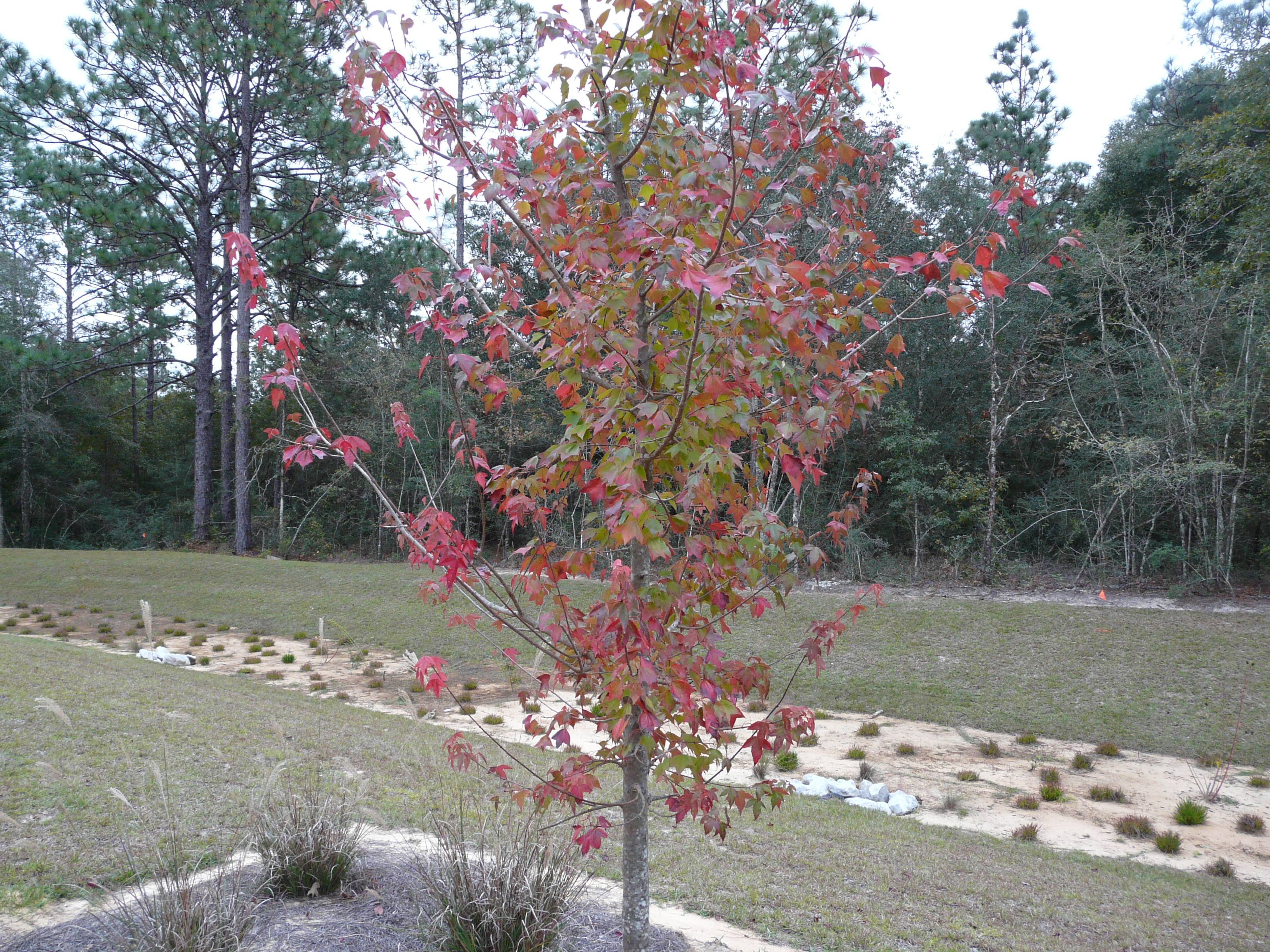
by Matt Lollar | Dec 16, 2021
Trees provide shade, aesthetics, and perspective to the landscape. However, they only serve as burdens if not properly selected and maintained. To help determine what trees do best under certain conditions and to provide information on tree care, this month’s Gardening in the Panhandle LIVE! was all about trees.
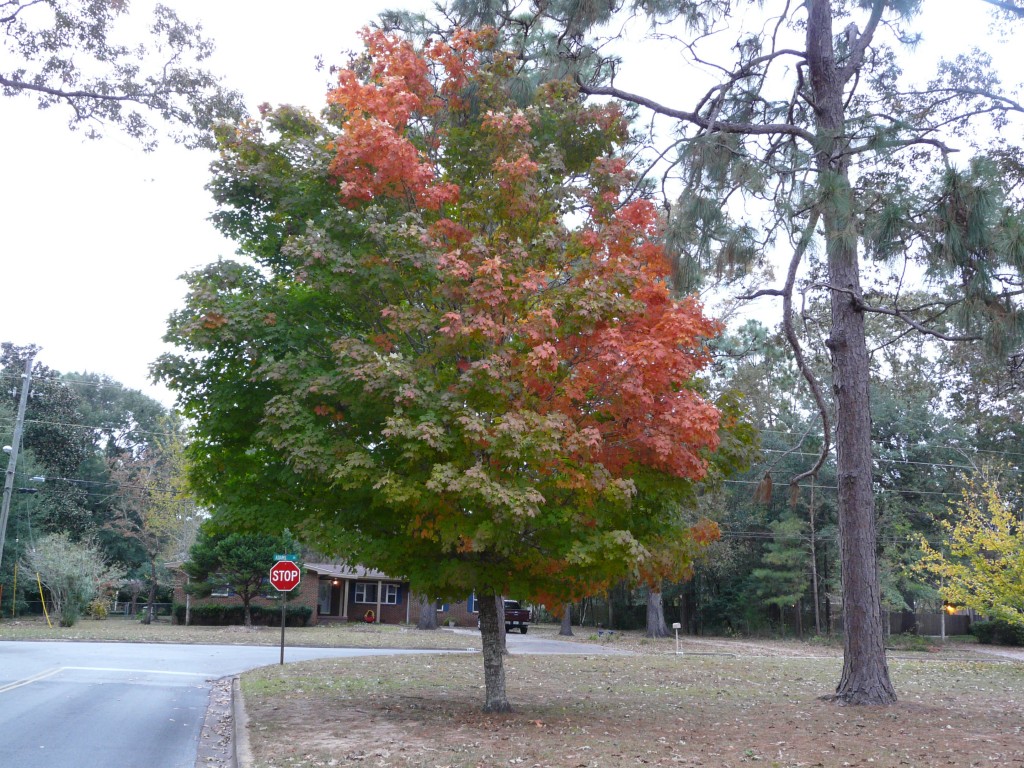
Florida maple beginning to exhibit fall color. Photo credit: Larry Williams, University of Florida/IFAS Extension – Okaloosa County
Tree Selection
Some trees grow faster than others. That’s not always a good thing, but if you’re trying to select a tree that grows fast and will provide shade in your yard then you might want to give the following species a try. Click on the links for more information.
A lot of times you’ll read a particular tree species prefers moist, well-drained soil. Some coastal soils are very well drained and require supplemental irrigation after establishment to keep some species alive. One tree that does well in sandy, well-drained soils without supplemental irrigation is the sand live oak. Another tree, that would never win a popularity contest, but does well in sandy soils is the sand pine. This tree has a gnarly growth habit, which would make it an interesting focal point in the landscape. Turkey oaks are another option for dry spots.
There are a lot of fruit tree species that can be grown successfully in the panhandle. The key to good fruit production is selecting trees that are adapted to the average number of chill hours (usually calculated by the number of hours between 34ºF and 45ºF) your yard receives on a yearly basis. Some peaches, plums, and nectarines have been developed for our climate. Citrus such as satsumas and tangerine hybrids grow well in the panhandle, but sometimes require cold protection. Persimmons, loquats, and pears are other fruit trees that grow well.
If you already have mature trees in your yard, then you may be looking for smaller, understory trees to enhance your landscape.
Living this far south, you often have to really seek out trees that change color in the fall. Dogwoods, Florida maples, and blackgum trees all have great fall color. Some of the red oaks also have nice fall color. Two that come to mind are the nuttall oak and the Shumard oak.
Trees can cause a lot of damage if planted too close to sidewalks or buildings. To determine if a tree will fit in a confined space, you will need to consider its mature trunk flare diameter.
Florida is the southern extreme for growing ginko trees. If you decide to plant a ginko tree, make sure to select a male cultivar to avoid stinky, slippery fruit.
To successfully plant a tree, you need to start with a healthy tree. If the tree you purchase was grown in a pot, make sure it isn’t rootbound and doesn’t have encircling roots. You also should inspect the tree’s form, branching structure, and look for the presence of included bark. Please read “Selecting Quality Trees from the Nursery” for more tips on what to look out for when purchasing a healthy tree.
Some trees are more tolerant than others of high winds and flooding. Please read this publication about tree failure from hurricanes to help determine what tree species are better adapted to these weather events.
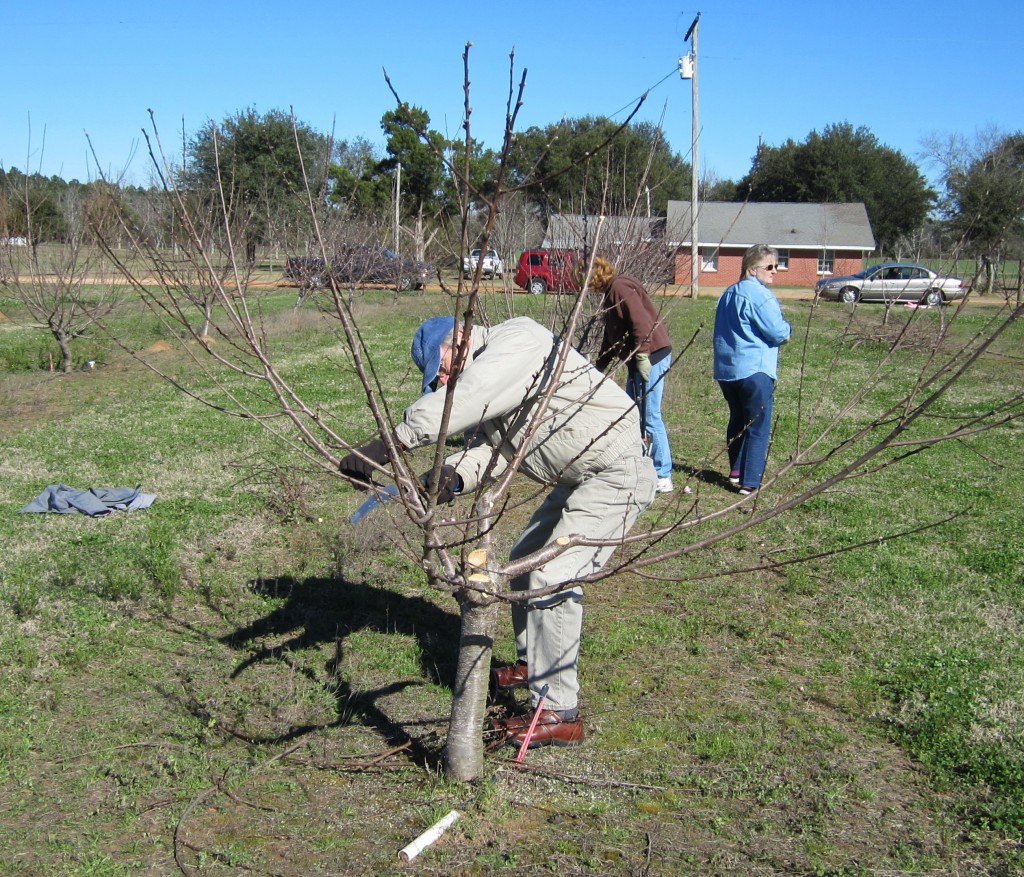
Santa Rosa County Master Gardener Pruning a Stone Fruit tree at the WFREC. Photo Credit: University of Florida/IFAS Extension
Tree Maintenance
Armillaria is a common fungal pathogen that infects trees from their roots. Other major diseases are more specific to certain species. A more comprehensive list of tree and shrub diseases can be found on the Ask IFAS website.
Tree establishment period depends on a lot of factors. Once a tree is established, it’s roots can be equal to about three times the distance from the trunk to the dripline.
Part of the beauty of a bald cypress is its knees. However they can also be a nuisance for mowing and other yard maintenance. The purpose of cypress knees is a bit of a mystery and there are a lot of theories on the subject.
Fallen leaves can help add nutrients back to your yard. Even if you are trying for a manicured lawn, you may want to rake up the leaves and use them elsewhere in the landscape.
Regardless of the species, most fruit trees benefit from a good pruning. Deciduous fruit trees should be pruned to maintain good branch structure and form, while citrus may benefit from a light hedging.
Trees are a wonderful addition to any landscape, but it’s important you select the right tree for the right place. Hopefully this article provided some information to guide you in the right direction.
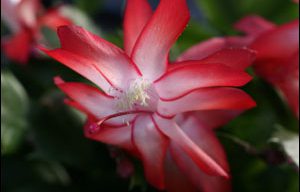
by Matt Lollar | Nov 22, 2021
Houseplants can soften up the interior of your home and help clean the air. They can also supplement your holiday decorations and help create stunning focal points. To help determine what plants do best under certain conditions and to give pointers on plant care, this month’s Gardening in the Panhandle LIVE! was all about houseplants.
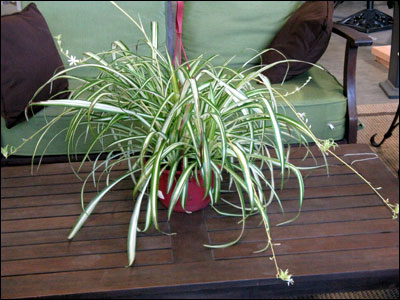
A spider plant on a coffee table. Photo Credit: University of Florida/IFAS
Environmental Conditions for Houseplants
Unless you live in a glass house, you’ll probably want to choose houseplants that do well in low light conditions. A guide for what light level different houseplants prefer can be found on the Gardening Solutions Light for Houseplants page. This page also provides useful tips on supplemental lighting.
Some houseplants are better at cleaning the air than others. A list of houseplants that do a good job improving indoor air quality can be found on the Gardening Solutions Houseplants That Clean the Air page.
The best way to determine if your houseplants need water is your own green thumb or whatever finger you choose to stick in the potting mix, but for some interesting information on outdoor soil moisture meters check out this informative publication on soil moisture sensors.
Houseplants need a good quality, well-drained potting mix to thrive. Tips on selecting a potting mix can be found on the Gardening Solutions Container Media page.
Houseplant Pests
One of the best ways to rid houseplants of insect pests is to set the plants outside for a few days and let the pests move on. For some information on pest control products in and around the home check out the publication Natural Products for Managing Landscape and Garden Pests in Florida.
Fungus gnats are mainly a nuisance, but some species can feed on living plant tissue. Darkwinged fungus gnats are known to feed on ferns, orchids, and geraniums.
Houseplant Propagation
One way to increase your houseplant population and save a few dollars is to propagate your own plants. The University of Florida/IFAS created the Plant Propagation Glossary to help with any propagation questions you may have.
Air layering is a propagation technique that not only allows the prospective plant to thrive from the nutrients of the mother plant, but it also saves space.
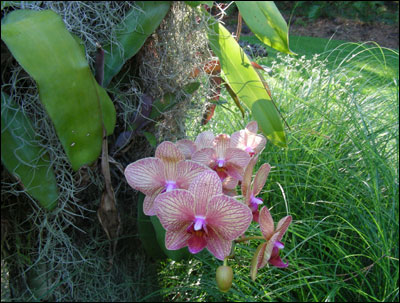
A moth orchid (Phalaenopsis spp.) outdoors. Photo Credit: University of Florida/IFAS
Specific Species Info
Orchids in the genus Phalaenopsis are easier to care for than other genera of orchids. The American Orchid Society provides some great tips on caring for orchids indoors. Some people choose to water their orchids with ice cubes. The Ohio State University has a publication that provides some more insight on watering Phalaenopsis orchids with ice cubes.
A lot of cacti do well indoors. A popular cactus during the holiday season is Christmas cactus. Christmas cactus have interesting foliage, but their blooms are what people want to see. Some tips on getting your Christmas cactus to bloom on time and general care information can be found in this Christmas Cactus Preparation fact sheet.
Have you ever wanted to grow fruit trees indoors or do you want some tips on bringing containerized fruit trees indoors for the winter? The Growing Fruit Crops in Containers publication provides some good tips on growing fruit trees indoors.
Unless you have a house with a lot of windows or a sunroom, plumeria don’t make the best houseplants. They need at least six hours of sunlight per day and need to be at least three years old to bloom. If you are interested in propagating plumeria, then check out this publication on propagating plumeria from cuttings.
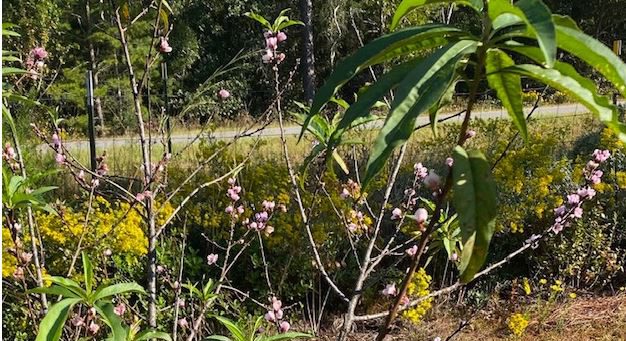
by Larry Williams | Nov 4, 2021
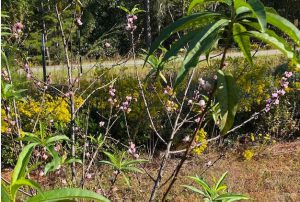
Peach tree blooming in fall. Note the yellow fall flowers of goldenrod & aster blooming in background. Photo credit: Leslie Hauquitz
Some fruit trees that normally bloom in late winter and spring are blooming now. Recently, a lady who had been out of town noticed that her peach trees were blooming when she arrived home. Knowing that peach trees ordinarily bloom around spring, she called me about this unusual occurrence. This unseasonal flowering also is occurring on some other fruit trees such as crabapple, apple and pear. This phenomenon also can occur in other deciduous spring flowering trees such as Japanese magnolia.
Anything that results in the leaves falling earlier than normal can result in this blooming out of season. Stresses that can result in the leaves falling prematurely include late season storms, insects and foliage diseases. This year’s excessive rains favored foliage diseases resulting in early leaf drop in many trees.
During most years, normal leaf drop in these trees occurs later in the season as the day length becomes shorter and when temperatures are cooler. Cooler temperatures prevent the flower buds from swelling and opening. However, if the leaves fall when the day length is longer and the temperature is warmer, the flower buds will swell and open. The leaves prevent the flower buds from developing. If the leaves fall early, during late summer or early fall, the flowers are allowed to open. With commercial apple production in some parts of the world, chemicals are applied to intentionally remove the leaves to force a second crop after harvesting the first crop of apples. This practice would not work in our area because there is not enough time to mature a second crop of fruit before cold weather arrives.
It is possible for a second crop of small fruit to develop on fruit trees that are blooming now as a result of the second flowering this year. However, because of the colder weather that will be arriving as we move into winter, any such fruit will not have time to mature. When the first killing frost or freeze occurs, these young fruits will be killed.
The lady who called about her peach trees wanted to know if she should remove the flowers and if this late flowering would negatively impact next spring’s flowering and fruit production. The flowers that opened this fall will be absent in spring – reducing the total number of flowers. However, during most springs, fruit trees produce more blooms and subsequently fruits than the trees can support. As a result, this unseasonable blooming should result in a needed thinning in next spring’s fruit crop.
So, there’s no need to remove them…just enjoy this “surprise” flower show.












